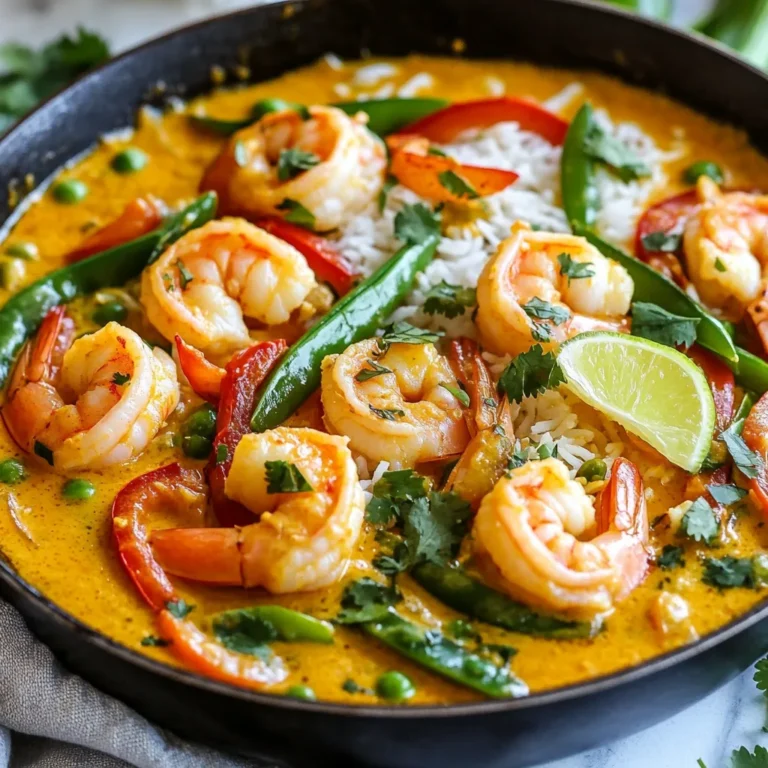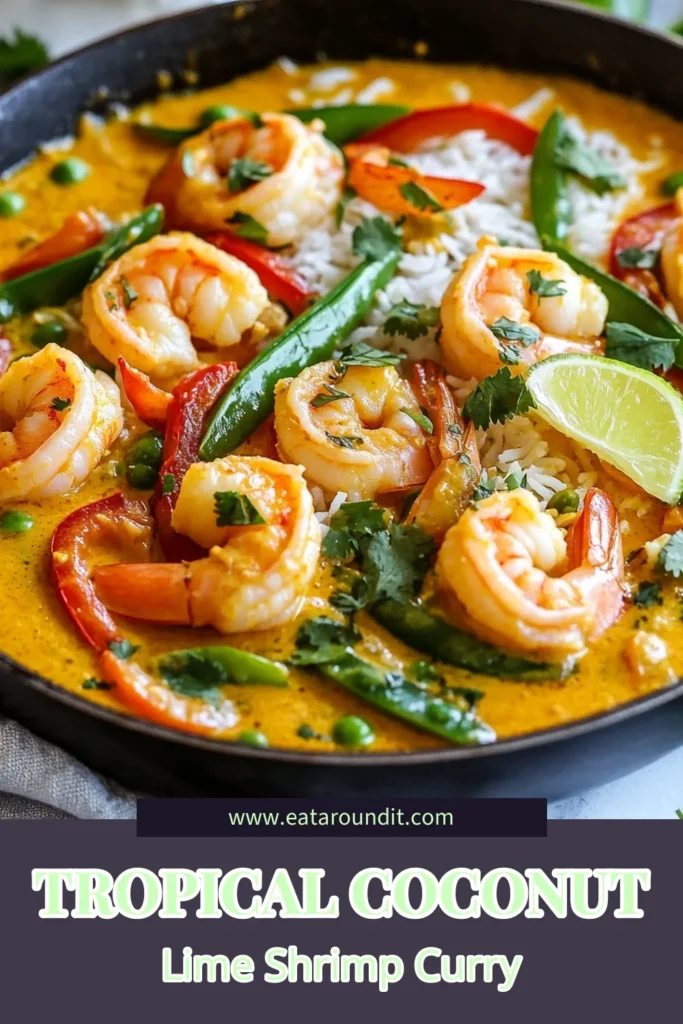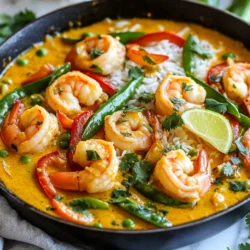WANT TO SAVE THIS RECIPE?
Are you ready to dive into a burst of tropical flavors? My Coconut Lime Shrimp Curry Skillet is a quick and tasty dish that brings the beach to your kitchen. With fresh ingredients and easy steps, you’ll create a meal that impresses everyone. Let’s explore how to make this flavorful delight that’s perfect for any night of the week. Your taste buds will thank you!
Why I Love This Recipe
- Bold Flavors: This dish combines the creamy richness of coconut milk with the zesty brightness of lime, creating an incredibly flavorful experience that transports you to a tropical paradise.
- Quick and Easy: With a prep time of just 10 minutes and a total cooking time of only 25 minutes, this recipe is perfect for a weeknight dinner without sacrificing taste.
- Healthy Ingredients: Packed with fresh vegetables and shrimp, this curry is not only delicious but also a nutritious option for those seeking a balanced meal.
- Customizable: Adjust the heat by varying the amount of red curry paste used, and feel free to add your favorite veggies for a personal touch to this versatile dish.
Ingredients
List of Ingredients
– 1 lb (450g) large shrimp, peeled and deveined
– 1 can (14 oz) coconut milk
– 2 tablespoons coconut oil
– 1 medium onion, finely chopped
– 2 garlic cloves, minced
– 1 tablespoon fresh ginger, grated
– 1 red bell pepper, sliced
– 1 cup snap peas
– 2 tablespoons red curry paste
– 2 tablespoons freshly squeezed lime juice
– Zest of 1 lime
– Salt and freshly ground black pepper, to taste
– Fresh cilantro leaves, for garnish
– Cooked jasmine rice, for serving
Importance of Fresh Ingredients
Using fresh ingredients makes a big difference in this dish. Fresh shrimp tastes sweet and tender. Fresh coconut milk adds a rich, creamy texture. Fresh herbs, like cilantro, bring bright flavor. Fresh vegetables keep their crunch and color. They help create a dish that is not only tasty but also healthy. When you select the best ingredients, you create a meal that brings joy with every bite.
Suggested Alternatives
You can swap some ingredients if needed. For shrimp, try chicken or firm tofu for a vegetarian option. If you can’t find coconut milk, you can use almond milk or soy milk, though the flavor will change. Red curry paste can be replaced with green curry paste if you like a different taste. For veggies, feel free to add broccoli, carrots, or bell peppers of any color. These changes can help you match the recipe to your taste and what you have on hand.

Step-by-Step Instructions
Preparing the Skillet
First, heat 2 tablespoons of coconut oil in a large skillet over medium heat. Wait until the oil melts and shimmers. This oil gives a rich flavor to the dish. It also helps cook the shrimp and veggies evenly.
Cooking the Aromatics
Once the oil is hot, add 1 medium onion, finely chopped. Sauté it for 3-4 minutes. Stir often until the onion gets soft and turns translucent. Next, add 2 minced garlic cloves and 1 tablespoon of grated ginger. Cook for 1 more minute. This step fills your kitchen with a warm, inviting aroma.
Adding the Vegetables and Curry Paste
Now, toss in 1 sliced red bell pepper and 1 cup of snap peas. Stir constantly for about 3 minutes. You want them to soften but still stay crisp. Then, add 2 tablespoons of red curry paste. Mix it well, coating all the veggies. Cook for another minute to develop the flavors.
Incorporating Coconut Milk and Shrimp
Carefully pour in 1 can of coconut milk. Stir gently to combine everything. Increase the heat slightly and bring it to a gentle simmer. Now, it’s time to add 1 pound of large shrimp. Cook for 4-5 minutes. Stir occasionally until the shrimp turn pink and opaque. This shows they are fully cooked.
Final Seasoning Steps
After cooking the shrimp, add 2 tablespoons of fresh lime juice and lime zest. Season with salt and freshly ground black pepper to taste. Stir well to mix in these bright flavors. Let the curry sit for a couple of minutes. This helps the flavors blend beautifully. Serve over jasmine rice, topped with fresh cilantro leaves for a colorful finish.
Tips & Tricks
Perfecting Shrimp Cooking Time
Cooking shrimp just right is key. Cook shrimp for 4-5 minutes. They should turn pink and opaque. Overcooking makes shrimp rubbery. To check, cut one open. If it’s white and firm, it’s perfect.
Adjusting Spice Levels
You can change the spice to fit your taste. Start with 2 tablespoons of red curry paste. If you want it hotter, add more paste or a dash of chili flakes. For less heat, use less paste. Always taste as you go. This way, you can adjust to your liking.
Enhancing Flavor with Fresh Herbs
Fresh herbs boost the flavor of your dish. Add cilantro at the end for a bright touch. You can also try fresh basil or mint. These herbs add a fresh taste that brightens the curry. For a twist, sprinkle some toasted coconut flakes as a garnish.
Pro Tips
- Use Fresh Ingredients: Always opt for fresh shrimp and vegetables to enhance the flavors of your curry.
- Adjust the Spice Level: Feel free to modify the amount of red curry paste to suit your heat preference.
- Let It Rest: Allowing the curry to sit for a few minutes after cooking helps the flavors meld together beautifully.
- Garnish for Flavor: Don’t skip the fresh cilantro; it adds a bright, fresh flavor that complements the curry perfectly.

Variations
Vegetarian Version with Tofu
You can easily make a vegetarian version of this dish. Replace the shrimp with tofu. Use firm tofu and cut it into cubes. Sauté the tofu until it is golden brown. Follow the same cooking steps as for shrimp. The tofu absorbs the coconut milk and curry flavors well. This swap keeps the dish rich and filling.
Alternative Protein Suggestions
If you want other protein options, consider chicken or fish. For chicken, use boneless thighs or breasts. Cut them into bite-sized pieces. Cook them until they are no longer pink, then add the coconut milk. For fish, choose a firm type like cod or tilapia. Cut it into chunks and add it when you mix in the coconut milk. Each option gives a new taste but keeps the essence of the curry.
Adding Other Vegetables
You can customize the curry by adding other vegetables. Try carrots, zucchini, or broccoli. Just cut them into small pieces. Add harder veggies first, so they have time to cook. Softer ones can go in later. This method ensures all the vegetables are tender and tasty. Each vegetable adds a unique flavor and texture to your dish.
Storage Info
Refrigeration Tips
Store any leftover coconut lime shrimp curry in an airtight container. Place it in the fridge within two hours of cooking. It can stay fresh for up to three days. Make sure to let it cool before sealing the container. This helps keep the shrimp tender and the sauce creamy.
Reheating Instructions
When you’re ready to enjoy your leftover curry, reheat it gently. Use a saucepan over low heat. Stir it often to ensure even warming. You can also use a microwave. Heat in short bursts, stirring in between. This way, you prevent the shrimp from becoming rubbery.
Freezing Suggestions
If you want to save the curry for later, freezing is a great option. Let it cool completely before transferring it to a freezer-safe container. It can last up to three months in the freezer. When you’re ready to eat, thaw it overnight in the fridge. Then, follow the reheating instructions to enjoy a taste of tropical bliss again!
FAQs
Can I use frozen shrimp?
Yes, you can use frozen shrimp. Just thaw them first in cold water. This will help them cook evenly. Frozen shrimp saves time and is handy to have on hand.
How do I make the curry spicier?
To add heat, use more red curry paste. You can also add sliced fresh chili peppers. Adjust the spice level to fit your taste. Start small and add until it’s just right for you.
What can I serve with Coconut Lime Shrimp Curry?
I love serving this curry with jasmine rice. The rice soaks up the sauce well. You could also try naan bread or quinoa. Fresh lime wedges on the side add brightness.
How long does the dish last in the fridge?
The dish lasts for 3 to 4 days in the fridge. Store it in an airtight container. Reheat gently on the stove or in the microwave. Enjoy the flavors even after a few days!
This blog post covered the key elements for making Coconut Lime Shrimp Curry. You learned about the importance of fresh ingredients and found helpful cooking steps. I shared tips on cooking shrimp perfectly and adjusting spice levels. You also discovered tasty variations like a vegetarian option. Proper storage information ensures you can enjoy leftovers too.
Remember, cooking is fun. Experiment with flavors and ingredients. Enjoy your culinary journe
Coconut Lime Shrimp Curry Skillet
A tropical and flavorful shrimp curry cooked in coconut milk, perfect for a quick meal.
Prep Time 10 minutes mins
Cook Time 15 minutes mins
Total Time 25 minutes mins
Course Main Course
Cuisine Thai
Servings 4
Calories 350 kcal
- 1 lb large shrimp, peeled and deveined
- 1 can coconut milk (14 oz)
- 2 tablespoons coconut oil
- 1 medium onion, finely chopped
- 2 cloves garlic, minced
- 1 tablespoon fresh ginger, grated
- 1 red bell pepper sliced
- 1 cup snap peas
- 2 tablespoons red curry paste
- 2 tablespoons freshly squeezed lime juice
- 1 lime zest
- to taste salt and freshly ground black pepper
- for garnish fresh cilantro leaves
- for serving cooked jasmine rice
Begin by heating 2 tablespoons of coconut oil in a large skillet over medium heat until fully melted and shimmering, ensuring it covers the base of the skillet evenly.
Once the oil is hot, add the finely chopped onion. Sauté for about 3-4 minutes, stirring occasionally, until the onion becomes soft and translucent.
Next, incorporate the minced garlic and grated ginger into the skillet. Cook for an additional minute, stirring frequently, until the mixture is fragrant and aromatic.
Add the sliced red bell pepper and snap peas to the skillet. Stir constantly for about 3 minutes, allowing the vegetables to soften slightly while maintaining a firm texture.
Then, mix in the 2 tablespoons of red curry paste, ensuring it evenly coats the vegetables. Continue to cook for an extra minute to further develop the flavors.
Carefully pour in the coconut milk, stirring gently to combine all the ingredients thoroughly. Increase the heat slightly and bring the mixture to a gentle simmer.
Add the shrimp to the skillet, cooking for 4-5 minutes, stirring occasionally, until the shrimp turn pink and opaque, indicating they are cooked through.
After the shrimp are cooked, season the curry with 2 tablespoons of lime juice, lime zest, and salt and freshly ground black pepper to taste. Stir well to incorporate these bright flavors.
Remove the skillet from heat and let the curry sit for a couple of minutes. This resting period allows the flavors to meld beautifully.
To serve, spoon the delicious coconut lime shrimp curry over bowls of jasmine rice and finish with a generous sprinkle of fresh cilantro leaves for a burst of color and flavor.
For added texture and flavor, top your curry with toasted coconut flakes or a slice of lime on the side. Enjoy this delightful dish while savoring the tropical essence!
Keyword coconut, curry, lime, quick meal, shrimp
WANT TO SAVE THIS RECIPE?





